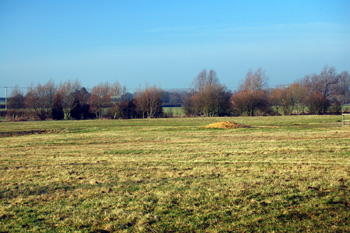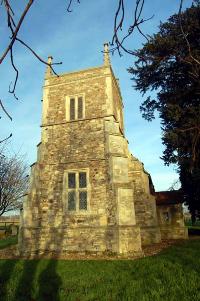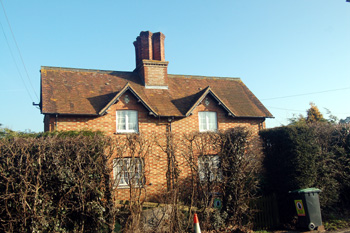The Community of Hulcote in General

Countryside looking towards Salford January 2011
Landscape
Volume III of The Victoria County History for Bedfordshire was published in 1912. It states that Hulcote contained 905 acres (360 hectares). At that time 279 acres were arable and 555½ were grassland, the rest being woods, plantations and buildings. Crops were wheat, barley, beans and peas.
The solid, or underlying, geology is a type of mudstone known as Oxford Clay Formation, laid down between 154 and 164 million years ago in warm, shallow Jurassic seas. This ensures a clay soil, except along watercourses where the superficial geology is a mixture of clay, silt, sand and gravel called alluvium. The main drainage is a small stream which runs north-west into Salford.
The highest point lies in the north-east of the parish at Holcot Wood: it is at 386 feet above sea level. The lowest part of the parish lies along the stream where Hulcote Mill stands and this is at 250 feet. The church stands at 280 feet above sea-level.

Hulcote sign January 2011
Name
Hulcote is also spelled Holcot and seems to come from the Old English word "holh" meaning hollow ground combined with the word cottages – thus cottages in the hollow. The name has appeared in the following forms over the years:
- Holacotan: 969-1229;
- Holecote: 1086-1428;
- Holekote: 1086-1428;
- Hulecote: 1240;
- Holcote: 1315 and afterwards;
- Hulcote: 1461;
- Hulcott: late 16th century;
- Howcott alias Hulcott: late 16th century.

Hulcote church February 2007
Administrative History
Hulcote is an ancient parish, though evidence is that it began as a hamlet of Aspley Guise. Aspley is first mentioned in a charter of 969 when King Edgar granted 15 hidesin the parish to his thegn Alfwold (a relative of the King's by marriage). The text of the charter of 969 (which is not held by Bedfordshire & Luton Archives & Records Service) was translated in Bedfordshire Historical Records Society volume V (1919) by George Herbert Fowler, the first CountyArchivist. When laying out the parish boundaries it states: "From the stream to Cranefeld dyke; from the dyke to the old charcoal pit where the three boundaries meet, of Cranefeld men, and of Mereston men, and of Holacot; from these three boundaries to the old maple tree; from the maple tree on to the long corner, always by the High Wood to the tall thorn tree; from the thorn tree again to the Hysse Burn, again to the eastward of Wendlesdun". This implies that the boundaries of Aspley Guise included Hulcote, otherwise the boundary of Aspley Guise could not include the place where the boundaries of Cranfield, Marston Moretaine and Hulcote met".
Hulcote was a parish with its own manor by the time of the Domesday Book of 1086 and continued as a separate parish until 1750 when the ecclesiastical parish was united with that of Salford. The civil parish was abolished and, again, united with that of Salford in 1933.
The boundary line between Hulcote and Salford to the north and Aspley Guise to the south used to follow the line of the stream on which Hulcote Mill stood. In 1984 the boundary was changed to be the middle of the M1 thus giving Hulcote and Salford a good deal of additional land, including the area known as Salford Ford in the vicinity of the Red Lion [CDP82].
Hulcote is bordered to the south-east by Husborne Crawley, to the south by Aspley Guise and to the west by Salford, to the north by Cranfield and to the east by Brogborough (formerly by Ridgmont, Brogborough having been a hamlet in that ancient parish.

Rectory Cottage January 2011
Population
The Domesday Book of 1086 records 14 people in Hulcote. These are just the heads of households and so the figure must be multiplied by a factor of at least four, suggesting around 56 people. Given that the population of England was only 1,500,000 to 2,500,000 at that date Hulcote was obviously a proportionately larger place than in 1801 when the country's population was over 8,000,000.
Hulcote, though, has never a large settlement. Census figures from 1801 onwards show it at its largest in 1861 and 1871 with just 71 people! The following figures are for Hulcote until 1931 and for Hulcote and Salford combined from 1951.
1801: 65;
1811: 68;
1821: 62;
1831: 49;
1841: 62;
1851: 62;
1861: 71;
1871: 71;
1881: 54;
1891: 48;
1901: 45;
1911: 49;
1921: 57;
1931: 39.
For Hulcote and Salford combined:
1951: 233;
1961: 207;
1971: 179;
1981: 207;
1991: 182;
2001: 182;
2011: 209.